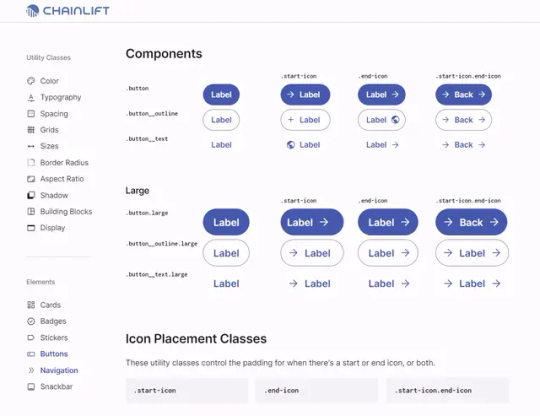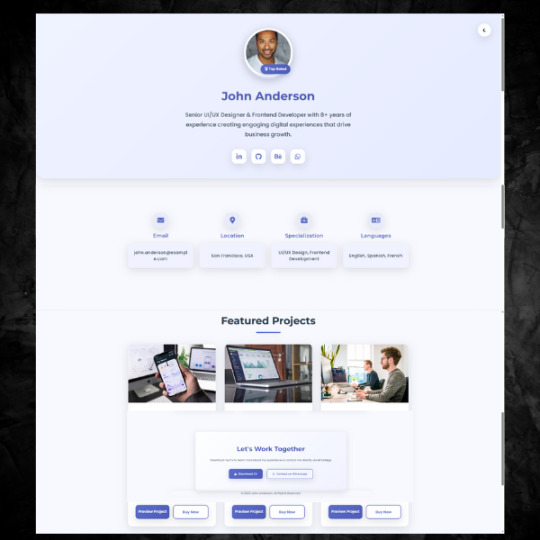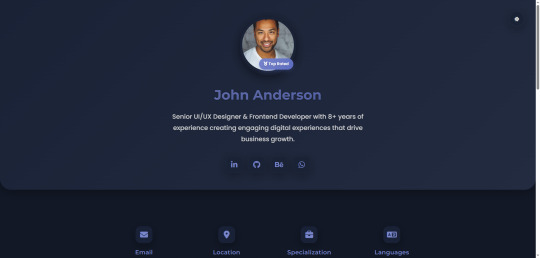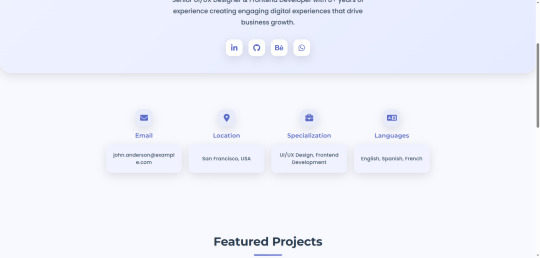#ui card css
Explore tagged Tumblr posts
Text

Movie Card UI Design
#movie card ui design#movie card css#css cards#responsive card design html css#html css#codenewbies#frontenddevelopment#css#html5 css3#webdesign#pure css tutorial#basic html css tutorial#responsive web design
2 notes
·
View notes
Video
youtube
Card Hover Effect in CSS | Card UI Design in 2024 | Devhubspot
0 notes
Video
youtube
Card Hover Effect in CSS | Card UI Design in 2024 | Devhubspot
0 notes
Video
youtube
Card Hover Effect in CSS | Card UI Design in 2024 | Devhubspot
0 notes
Video
youtube
🔴 Real Glassmorphism Card Hover Effects | Html CSS Glass Tilt Effects | ...
#youtube#devhubspot#card#effect#tilt#html#html css#html5#html5 css3#html website#css#css3#ui#ui ux design#uidesign#tumblr ui
1 note
·
View note
Video
youtube
🔴 Animated Profile Card UI Design using Html & CSS | devhubspot
0 notes
Text
Build Clean, Modern UIs with Golden Ratio Scaling - LiftKit CSS
LiftKit CSS is a lightweight, 100% free CSS framework developed by Chainlift. It’s a set of utility classes and UI components designed with golden ratio scaling, which helps you create clean, modern web projects. Utility Classes: Color Typography Spacing Grids Sizes Border Radius Aspect Ratio Shadow Layout Blocks Display UI Elements: Cards Badges Stickers Buttons Navigation Snackbar More…

View On WordPress
2 notes
·
View notes
Text
Card UI Design: https://codepen.io/sam_garcia2/pen/dyoKENR More CSS product cards: https://freefrontend.com/css-product-cards/
4 notes
·
View notes
Text
Profile-Pro - Ultimate Personal Portfolio Template
LIVE DEMO | BUY NOW

Profile-Pro is a professionally designed personal portfolio template that showcases your skills, experience, and projects with elegance and impact. Crafted for modern professionals who want to make a lasting impression, this template combines aesthetic appeal with functional excellence.

Why Choose Profile-Pro?
Modern Design Aesthetics: Sleek interface with harmonious colors and sophisticated effects
Exceptional User Experience: Perfect contrast, subtle shadows, and smooth transitions
Fully Responsive: Flawless performance on mobile, tablet, and desktop devices
Day/Night Mode: Eye-friendly theme switching with automatic preference saving
Professional Project Showcase: Elegant portfolio section to highlight your best work
Easy Customization: Simple modification to match your personal brand identity

Key Features & Capabilities
Professional Design
Modern UI with sophisticated styling
Harmonious color scheme with customization options
Precise shadows creating depth and elegance
Theme Switching
One-click toggle between light/dark modes
Automatic user preference saving
Seamless design consistency across both themes
Fully Responsive
Adaptive layout for all screen sizes
Consistent user experience across devices
Smart element and text scaling
Project Showcase
Elegant project grid layout
Project cards with impressive hover effects
Clear action buttons (Preview/Buy)

Contact Information
Innovative information card design
Icon-based contact details
Social media integration
Performance Optimized
Lightweight codebase for fast loading
Clean HTML/CSS without frameworks
SEO-friendly structure
License
This template is released under the MIT License - free for personal and commercial use with attribution. See LICENSE file for details.
Quick Start
Download the template files
Customize content in index.html
Replace images with your own
Deploy to any hosting service

Transform your online presence with Profile-Pro - where professionalism meets design excellence!
#css#html#html css#htmlcoding#js#Profile page#landing page design#ui ux design#design#template#template design#landing page#landing page builder#landing pages#panel#coding
0 notes
Text
The Role of Motion UI in Web Development: Adding Delight to UX
In the age of digital-first interactions, user expectations are higher than ever. They don’t just want fast-loading websites—they want smooth, intuitive, and engaging experiences. One of the most powerful tools to achieve this is Motion UI—the strategic use of animations and transitions to guide, inform, and delight users.
Modern Web Development Company teams are increasingly integrating Motion UI into their workflow not just to make interfaces look good, but to enhance usability, improve storytelling, and make digital experiences feel more human. When used well, Motion UI turns static screens into dynamic journeys that users enjoy navigating.
What Is Motion UI?
Motion UI refers to the use of animated elements within a digital interface to convey meaning, improve interaction, and enhance aesthetic appeal. It includes elements like:
Smooth page transitions
Micro-interactions (e.g., button hover effects, toggles, loading spinners)
Scroll-triggered animations
Modal or menu reveals
Feedback animations (e.g., shake effect on invalid form input)
Unlike flashy or distracting animations, Motion UI is subtle, purposeful, and user-centric.
Why Motion UI Matters in Modern Web Development
1. Guiding User Attention
In a visually noisy digital space, animations can help direct the user’s eye to what matters most. Whether it’s drawing attention to a CTA, highlighting a newly loaded section, or showing the progress of a task, motion cues subtly guide behavior without overwhelming the user.
Why it matters: Strategic motion reduces cognitive load and enhances information hierarchy.
2. Providing Feedback and Affordance
Users feel more confident when the interface responds to their actions. Hover effects, loading animations, and success indicators provide instant feedback that confirms, “Yes, your action was registered.”
For example:
A button that slightly enlarges on hover indicates it’s clickable.
A form field that glows red upon error highlights correction needs.
A spinner after form submission reassures the user the process is underway.
Why it matters: Feedback builds trust and smooths interaction flows.
3. Creating Seamless Transitions
Instant changes on screen can feel jarring or disorienting. Motion UI introduces transitions between pages, states, or elements to soften the shift and help users understand how they arrived at the new state.
This could include:
Page fade-ins
Slide transitions in mobile navigation
Expanding cards or modals
Why it matters: Transitions help maintain context, making interactions feel more natural and logical.
4. Enhancing Brand Personality
Motion is also a storytelling tool. The style and speed of animations can reflect your brand’s personality—playful, elegant, modern, bold, etc. For instance, a creative agency’s website might use lively, bouncy transitions, while a law firm’s site may favor slow, smooth fades for a calm, professional tone.
Why it matters: Motion supports emotional connection and brand differentiation.
5. Improving Mobile and Touch UX
Motion UI isn’t just for desktops—it plays a vital role in mobile web design. Mobile users rely on gestures and need visual feedback more than ever. Swipe animations, touch transitions, and collapsible sections improve usability and reduce interface friction.
Why it matters: Fluid mobile motion contributes to better retention and conversion on handheld devices.
How Web Development Companies Use Motion UI Effectively
Strategic Planning, Not Overuse
Experienced developers use motion sparingly and intentionally. They prioritize usability over decoration and ensure motion supports functionality rather than distracting from it.
Performance Optimization
Heavy animations can affect performance, especially on low-powered devices. Agencies implement motion using:
CSS animations for lightweight transitions
JavaScript libraries like GSAP or Framer Motion for advanced effects
Lazy loading and hardware acceleration for smooth playback
Accessibility Considerations
Motion isn’t for everyone. Users with motion sensitivity may find transitions disorienting. Web development companies honor user preferences by respecting browser settings like “Reduce Motion” and offering toggle options where necessary.
Testing Across Devices
Motion must be consistent across browsers, screen sizes, and performance conditions. Agencies rigorously test animations to ensure they work well on all devices—without causing lag, layout shifts, or usability issues.
Final Thoughts
Motion UI isn’t about adding glitter—it’s about adding clarity, emotion, and flow to your user experience. When implemented strategically, it enhances usability, builds trust, and transforms your website from functional to unforgettable.
A professional Web Development Company understands how to balance motion with performance, accessibility, and brand storytelling. They don’t just build static websites—they craft immersive digital experiences where every interaction feels intuitive, responsive, and delightful.
0 notes
Text
🚀 From Novice to Pro: Build a Swiggy-Style Food App with React 18

Have you ever dreamed of building a food delivery app like Swiggy or Zomato using the most in-demand frontend library, React? Whether you're a beginner or looking to elevate your frontend development skills, React 18 opens up incredible possibilities—and the best way to master it is by getting hands-on.
Imagine being able to create a real-world food delivery platform, complete with features like dynamic menus, cart functionality, and routing—all from scratch. If that sounds like your jam, you're going to love the journey of learning React through the lens of building a Swiggy-style food app.
And here's the good news: you don’t have to do it alone. With the course Mastering React 18: Build a Swiggy-Style Food App, you’ll get everything you need—step-by-step guidance, real-world coding experience, and modern best practices.
Let’s break down why this is one of the smartest ways to learn React in 2025.
Why React 18 Is Still a Game-Changer in 2025
React has come a long way, but React 18 is where the future starts. With features like automatic batching, concurrent rendering, and the transition API, it brings smoother UI updates and better performance to your applications.
These updates are more than just technical improvements—they directly impact user experience. Whether you’re building a personal project or developing apps for clients, React 18 ensures that your interfaces are responsive, scalable, and lightning-fast.
In other words, learning React 18 gives you a serious edge in today’s frontend job market.
What Makes Building a Food Delivery App So Valuable?
You might wonder: why a food delivery app? Why not just build a to-do list or calculator?
Great question.
Here’s the truth: while basic projects help you learn syntax, real-world projects like a Swiggy-style app teach you how to think like a developer. They help you understand how to:
Structure components effectively
Manage application-wide state
Integrate APIs and fetch dynamic data
Use advanced features like lazy loading, routing, and conditional rendering
Optimize performance and manage code reusability
Plus, let’s be honest—a food app is way more fun to build and show off than a to-do list.
What You’ll Learn in This Course
The course Mastering React 18: Build a Swiggy-Style Food App isn’t just about React basics. It’s about learning to build a complete, fully-functional application that mimics the UX and UI of a real-world platform.
Here’s what you can expect to master:
🔹 Setting Up Your Development Environment
From setting up your folder structure to installing the latest React 18 version, the course walks you through everything. You'll even get hands-on with Vite or Create React App for fast and optimized development.
🔹 Component-Based Architecture
You’ll learn how to break your app into reusable, modular components—like headers, cards, menus, and cart elements—following modern practices.
🔹 Routing & Navigation
React Router DOM makes navigating through your app smooth and dynamic. Learn how to implement routes like Home, Restaurant Details, Checkout, and more.
🔹 State Management
Explore React’s built-in useState and useReducer hooks, and get introduced to state management tools like Redux Toolkit or Context API to manage global states like cart contents or restaurant menus.
🔹 Working with APIs
Discover how to fetch real-time data from mock APIs (or real ones!) and display it dynamically in your app. Learn about useEffect, asynchronous calls, and loading states.
🔹 Optimizing User Experience
Dive into performance tricks—like code splitting, lazy loading, and suspense—to make your app lightning-fast and SEO-friendly.
🔹 Responsive Design
Use CSS-in-JS, Tailwind CSS, or plain CSS to ensure your app looks great on all devices, from smartphones to desktops.
Who Is This Course For?
This course is for:
✅ Beginners who know some JavaScript and want to learn React by doing something practical ✅ Intermediate developers looking to refresh their skills and add a real-world project to their portfolio ✅ Freelancers & job seekers wanting to build portfolio-worthy projects that impress clients and employers
Whether you're aiming to land a job, freelance, or build your own startup, this course equips you with skills that truly matter.
Let’s Talk About Career Benefits 🎯
Once you’ve completed the app, you won’t just know React—you’ll own it. You’ll understand how to architect modern applications that can scale, perform, and delight users.
Employers love developers who:
Can build end-to-end projects
Understand state and data flow
Write clean, reusable code
Know how to debug and optimize
By learning through a real-world project like this food delivery app, you showcase exactly those skills.
Practical Features You’ll Build
To make things even more exciting, here are just some of the features you’ll bring to life in your food app:
🛍️ Cart Management
🍔 Dynamic Menus
📍 Restaurant Listings with Filters
📦 Add to Cart / Remove from Cart Functionality
🔄 Routing and Deep Linking
📲 Responsive Mobile Layout
🌐 SEO and Performance Optimization
By the end, you’ll have a polished app that looks and works like something you’d find on the App Store.
Why This Course Over Others?
There are dozens of React tutorials out there. So why pick this one?
Because it’s goal-oriented, real-world focused, and result-driven. Instead of showing you dry concepts in isolation, it walks you through a real business case: a Swiggy-style food app. It helps you think like a product engineer��not just a coder.
Also, this course is regularly updated, uses modern tooling, and helps you understand the why behind the how. That’s crucial when leveling up.
Learn by Doing: No More Tutorial Hell
The problem with most courses? You watch videos, nod along… and forget it all by the next day.
This course is different.
It encourages active learning. You’ll build the app alongside the instructor, write real code, and solve actual challenges. That’s the secret to mastering React and escaping “tutorial hell.”
Build Confidence Through Action
By the end of this course, you’ll have:
✅ A complete, responsive food delivery app in your portfolio ✅ A clear understanding of how React 18 works under the hood ✅ Real confidence to take on new frontend projects ✅ The ability to contribute to or lead React-based projects
It’s not just about watching someone code. It’s about gaining real experience that sticks.
Bonus: Reusable Codebase for Future Projects
Once you've completed the food app, you can reuse its architecture and logic for future e-commerce platforms, restaurant websites, or client projects. You’ll save time, work smarter, and deliver faster.
In short: you’ll have a strong foundation for your React journey.
Get Started Today
There’s no better time to learn React 18 than right now. The frontend ecosystem is thriving, and skills like these open doors—whether you want to work at a startup, land freelance gigs, or build your own product.
Ready to turn your coding dreams into reality?
👉 Mastering React 18: Build a Swiggy-Style Food App is the ultimate hands-on guide to modern React development.
Start building. Start growing. Start coding like a pro. 🚀
0 notes
Text

Profile Card Hover Animation
#profile card hml css js#profile card ui design#profile card design#profile card#profile card hover animation#css cards#css card hover animation#codenewbies#html css
1 note
·
View note
Video
youtube
🔴 Html CSS List UI Design with Cool Hover Effect | Devhubspot
0 notes
Text
Watch the demo of a glassmorphism profile card with social links. Clean, modern UI built using HTML and CSS. Full tutorial available on our blog.
0 notes
Text
Graphic Design Career Paths After Completing a Local Course

Graphic design is more than just creating eye-catching visuals—it’s about communicating ideas, solving problems, and enhancing user experiences through design. With the growing digital landscape, the demand for skilled graphic designers continues to rise across various industries. Many aspiring designers often begin by searching for graphic design courses near me to start their creative journey. These local courses not only offer foundational skills but also open doors to a variety of exciting and lucrative career paths.
1. Graphic Designer
The most direct career path is, of course, becoming a graphic designer. After completing a course, graduates can find work in advertising agencies, media houses, corporate design departments, or even as freelancers. Graphic designers work on everything from logos and brochures to social media graphics and website visuals. The ability to understand client needs, use design software effectively, and communicate visually is key in this role.
2. UI/UX Designer
With the boom in web and mobile applications, UI/UX design has become a high-demand field. While traditional graphic design focuses on aesthetics, UI (User Interface) and UX (User Experience) design go a step further to enhance functionality and user interaction. If your course included basics of interface design, you can specialize further in this area. A strong portfolio showcasing wireframes, prototypes, and app layouts will help you land roles in tech companies or startups.
3. Motion Graphics Designer
Motion graphics combine design with animation. It’s a growing niche where designers create engaging visual content for videos, advertisements, online platforms, and social media. If you enjoy animation or storytelling, this could be your ideal path. Many local courses now offer introductory modules in motion graphics, using tools like After Effects and Premiere Pro.
4. Brand Identity Designer
Every business needs a recognizable brand. Brand identity designers help companies create visual systems that define their look and feel—logos, typography, color schemes, and packaging design. This role requires creativity, strategic thinking, and the ability to understand a brand’s personality. A local course that covers branding principles and design thinking can set you on the right path toward this career.
5. Web Designer
While web development focuses on coding, web designers handle the aesthetic and functional layout of websites. They create site mockups, user-friendly designs, and cohesive visuals that reflect the brand identity. After completing a local course in graphic design, you can specialize in web design by learning HTML, CSS, and tools like Figma or Adobe XD. Businesses of all sizes now recognize the value of a well-designed website, increasing opportunities in this field.
6. Digital Illustrator
If you have a flair for drawing and creativity, digital illustration could be your calling. This role involves creating custom illustrations for books, blogs, advertisements, games, and more. Many local graphic design courses introduce you to illustration techniques using software like Adobe Illustrator or Procreate. As a digital illustrator, you can work as a freelancer, take on client projects, or collaborate with design studios.
7. Print Designer
Despite the digital shift, print design remains a vital part of marketing. From posters and banners to magazines and business cards, print designers create visuals that are both attractive and effective. Local courses often include lessons on print layouts, color theory, and prepress techniques. Understanding print materials and dimensions is essential to succeed in this traditional yet evolving field.
8. Freelance Designer or Design Entrepreneur
Many individuals who complete graphic design courses prefer to work independently. Freelancing allows you to choose your clients, projects, and schedule. Over time, experienced freelancers even build their own design studios or agencies. A strong portfolio, good communication skills, and business knowledge are vital for success. Local courses that include real-world projects or internships can give you the experience you need to get started.
9. Social Media Content Designer
In today’s content-driven world, brands constantly need fresh and engaging visuals for their social platforms. Social media content designers focus on creating posts, reels, banners, and stories that resonate with online audiences. If your course included design for digital platforms, this is a fast-paced and creative role worth exploring.
Final Thoughts
Completing a local graphic design course is just the beginning. The skills you gain—visual storytelling, software proficiency, and creative problem-solving—can lead you to multiple rewarding career paths. Whether you choose to specialize in UI/UX, branding, or motion graphics, the design world offers limitless opportunities.
If you're ready to start your journey and are still searching for graphic design courses near me, look for programs that offer hands-on experience, industry-relevant tools, and career support. With the right foundation and passion for design, you can turn your creativity into a fulfilling profession.
#GraphicDesign#DesignCareer#GraphicDesignCourses#LearnGraphicDesign#DesignEducation#DesignCourse#DesignLearning#GraphicDesignCoursesNearMe#ChandigarhDesignCourses#DesignJobs#UIUXCareer#DesignSkills#CareerInDesign#CreativeJobs#web series
1 note
·
View note
Video
youtube
🔴 Animated Profile Card UI Design using Html & CSS | devhubspot
1 note
·
View note